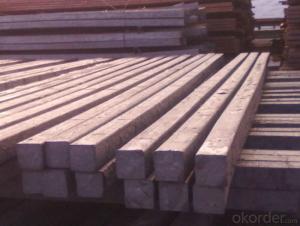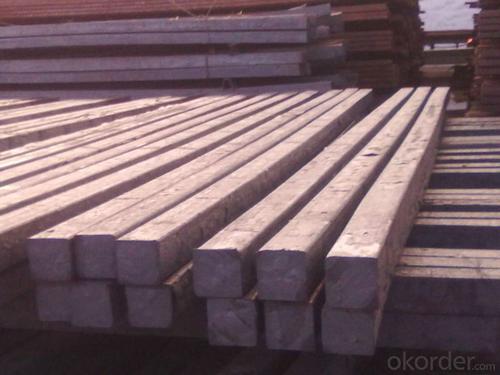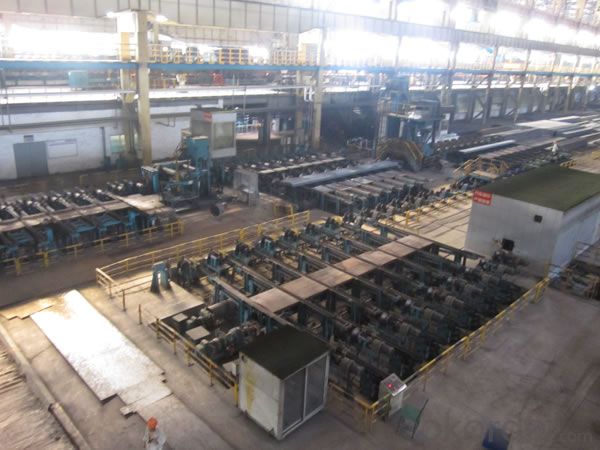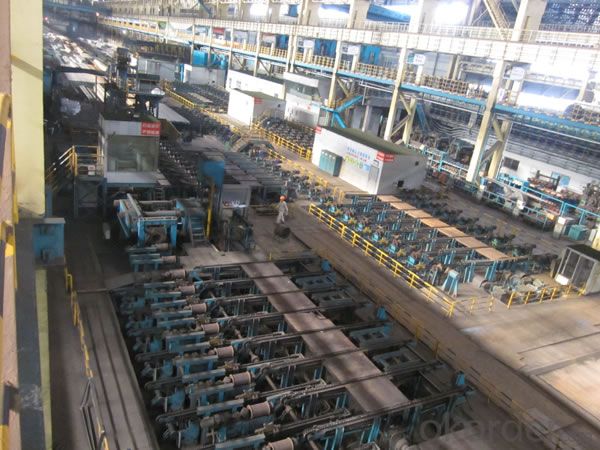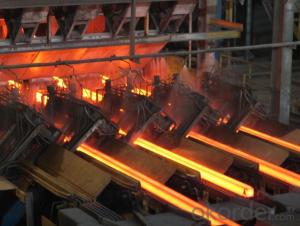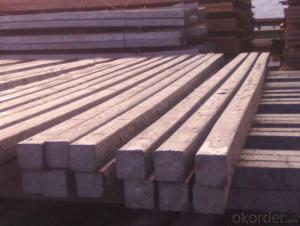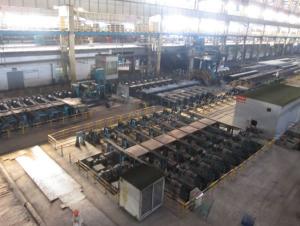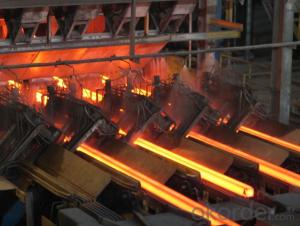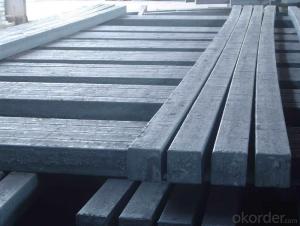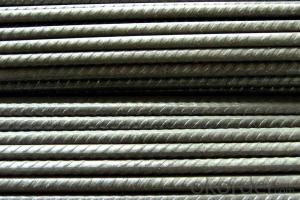Q235 3SP Square Steel Billet 105mm for Rebar
- Loading Port:
- Tianjin
- Payment Terms:
- TT OR LC
- Min Order Qty:
- 100 m.t.
- Supply Capability:
- 10000 m.t./month
OKorder Service Pledge
OKorder Financial Service
You Might Also Like
Description of Q235 3SP Square Steel Billet 105mm for Rebar
1. Prepainted steel coil is coated with organic layer, which provides higher anti-corrosion property and a longer lifespan than that of galvanized or galvalume steel sheets.
2. The base metals for prepainted steel coil consist of cold rolled, HDGI Steel, electro-galvanized and hot-dip alu-zinc coated steel. The finish coats of prepainted steel coil can be classified into groups as follows: polyester, silicon modified polyesters, polyvinylidene fluoride, high-durability polyester, etc.
3. The production process has evolved from one-coating-and-one-baking to double-coating-and-double-baking, and even three-coating-and-three-baking.
4. The color of the prepainted steel coil has a very wide selection, like orange, cream-colored, dark sky blue, sea blue, bright red, brick red, ivory white, porcelain blue, etc.
5. The prepainted steel coils can also be classified into groups by their surface textures, namely regular prepainted sheets, embossed sheets and printed sheets.
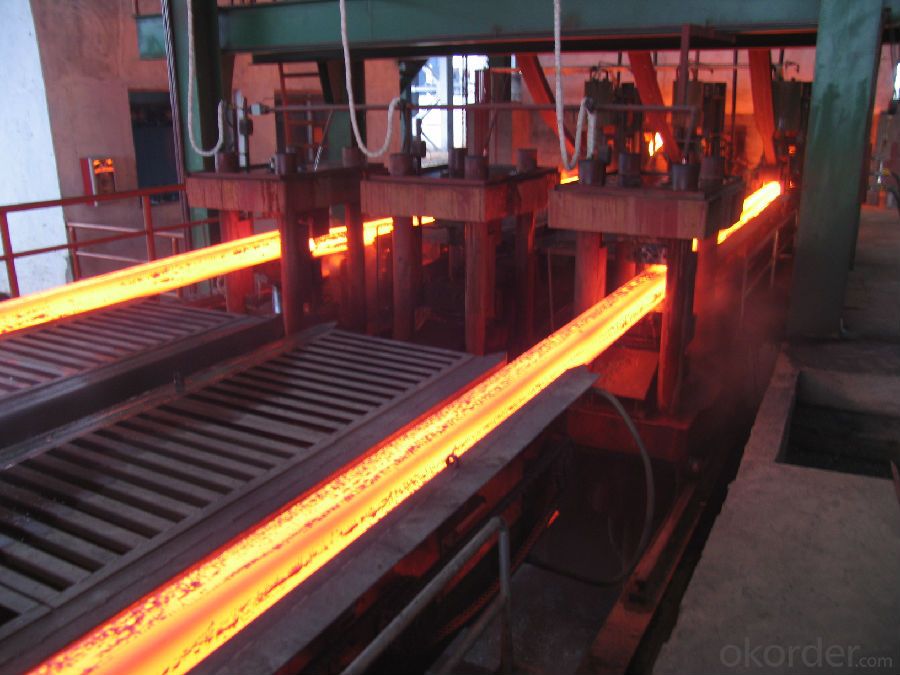
Main Feature of Q235 3SP Square Steel Billet 105mm for Rebar
Uncoated CR steel sheet
With the features of in line with the international highest standards in demension and shape, excellent surface finish and properties, the products are mainly used in home appliance and automobile industries.
Galvanized steel sheet(include HDG and EG)
With the features of good corrosion resistance, the products are mainly used in automobile, home appliance, electronics, building and machinery manufacture industries, etc.
Precoated steel sheet
With the features of enviromental protection and good processablility, long lasting surface durability, rich in colors, the products are maily used in building, home appliance and furniture industries, etc.
Applications of Q235 3SP Square Steel Billet 105mm for Rebar
A. Corrugated design makes it excellent waterproof performance
B. Materials as prepainted steel sheets, galvanized steel sheets, galvalume (Al-Zn coated sheets) are available to make corrugated sheet.
C.Those material are durable, anti-corrosion in bad weather for 20-30 years based on it's Zinc(Galvanized) coating or AZ (Galvalume) coating.
D. Different shape of the sheet make it suitable for any style of buildings.
E.Easy to install, no need special tools to fix the sheet.
F.Light weight due to high strength to weight ratio of steel. Light weight means easier handling lower shipping costs, easier installation
G. Different color is availbe base on the RAL Standard make your building more beautiful.
H. We will provide the best solutions if you don't have a exact idea of the specification you want for the steel sheet based on your weather conditions, engineering structure, construction budget and so on.
Specifications of Q235 3SP Square Steel Billet 105mm for Rebar
Product | Q235 3SP Square Steel Billet 105mm for Rebar |
Material Grade | SGCC / SGCH / DX51D+AZ, etc |
Thickness | 0.6-3.0mm |
Width | 500-1500mm |
Tolerance | Thickness: +/-0.02mm , Width:+/-2mm |
Zinc-coating | Z30-150g/m2 |
Technique | Raw material: Hot rolled steel coil --> Cold rolled_>hot dipped galvalume |
Surface | Dried, Chromated, Unoiled |
Spangle | Regular spangle , small spangle, zero spangle |
ID | 508MM 610MM |
Coil weight | 1-25MT |
Export package | Cardboard inner sleeves, Waterproof paper, galvanized steel covered and steel strip packed |
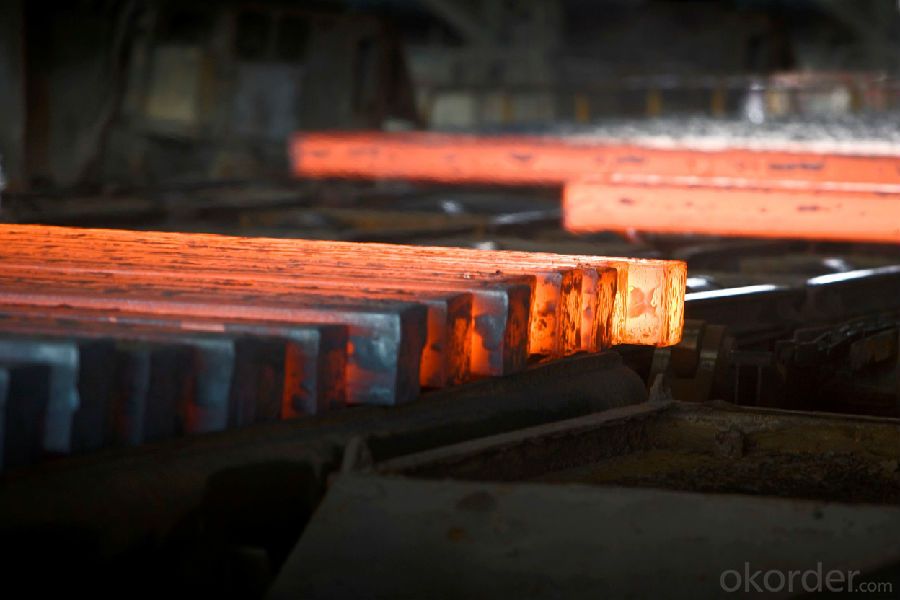
FAQ of Q235 3SP Square Steel Billet 105mm for Rebar
We have organized several common questions for our clients,may help you sincerely:
1. How Can I Visit There?
Our company is located in Tianjin City, China, near Beijing. You can fly to Tianjin Airport Directly. All our clients, from home or aboard, are warmly welcome to visit us!
2. How Can I Get Some Sample?
We are honored to offer you sample.
3. Why choose CNBM?
Our delivery time about 15-20days for standard sizes, if you have other requirements like hardness, quanity and width ,it is about 20-40days. But don't worry we also try our best for the delivery time ,because time longer and our cost is higher.
- Q: What is the average cost of steel billets?
- The average cost of steel billets can vary depending on factors such as the type, quality, quantity, and market conditions. It is recommended to check with steel suppliers or conduct market research to get the most accurate and up-to-date pricing information.
- Q: What are the common sizes and dimensions of steel billets?
- The common sizes and dimensions of steel billets vary widely depending on the specific industry and application. However, some common dimensions include square shapes ranging from 100x100mm to 300x300mm and rectangular shapes with dimensions of 200x300mm to 400x600mm. Additionally, cylindrical billets typically have diameters ranging from 100mm to 300mm. It is important to note that these dimensions can differ significantly based on the requirements of the end-use industry.
- Q: What are the different types of surface finish methods used for steel billets?
- There are several types of surface finish methods used for steel billets, each serving different purposes and achieving distinct surface characteristics. These methods include: 1. Hot rolling: This method involves passing the steel billet through a series of heated rollers, which compress and shape the material. The hot rolling process creates a smooth and glossy surface finish on the steel billet. 2. Shot blasting: In shot blasting, small metallic or non-metallic particles are propelled at high speeds onto the surface of the steel billet. This process removes any scale, rust, or contaminants, resulting in a clean and textured surface finish. 3. Pickling: Pickling is a chemical process that involves immersing the steel billet in an acid solution to remove any oxide scale or surface impurities. This method provides a smooth and corrosion-resistant surface finish. 4. Grinding: Grinding involves using abrasive wheels or belts to remove material from the surface of the steel billet. This process can be used to achieve a precise and smooth surface finish for various applications. 5. Polishing: Polishing is a mechanical process that uses abrasive materials to remove any imperfections or roughness from the surface of the steel billet. This method results in a high-gloss, mirror-like finish. 6. Cold rolling: Similar to hot rolling, cold rolling involves passing the steel billet through a series of rollers. However, in this process, the steel billet is not heated, resulting in a smoother and more precise surface finish. 7. Coating: Coating is a surface finish method that involves applying a protective layer or coating onto the steel billet. This can include paints, varnishes, or specialized coatings to enhance the appearance, durability, or corrosion resistance of the steel billet. Each of these surface finish methods has its advantages and is chosen based on the desired application, aesthetics, and functional requirements of the steel billet.
- Q: What is the typical impact strength of a steel billet?
- The typical impact strength of a steel billet depends on various factors such as the specific steel grade, heat treatment, and manufacturing process. However, steel billets generally possess high impact strength due to their toughness and resistance to fracture.
- Q: How are steel billets used in the production of structural steel sections?
- Steel billets are a crucial component in the production of structural steel sections. These billets serve as the primary raw material for the manufacturing process. To begin with, steel billets are melted in a furnace to create molten steel. This molten steel is then cast into billets of specific sizes and shapes, which can vary depending on the desired structural steel section to be produced. The billets are typically rectangular or square in shape. Once the steel billets have solidified, they are reheated in another furnace to a specific temperature for hot rolling. Hot rolling is a process where the billets are passed through a series of rolling mills to reduce their cross-sectional area and shape them into the desired structural steel sections. This process involves applying high pressure and temperature to the billets, which causes them to deform and elongate. The hot rolled steel sections are cooled and then undergo further processing, such as straightening, cutting, and sometimes additional heat treatment to enhance their mechanical properties. These steps ensure that the structural steel sections meet the required specifications for strength, durability, and dimensional accuracy. The structural steel sections produced from steel billets are widely used in various construction projects. They are commonly used in the construction of buildings, bridges, infrastructure, and other structures where strength and load-bearing capacity are essential. These sections can be found in beams, columns, channels, angles, and other shapes that provide the necessary support and structural integrity. Overall, steel billets play a vital role in the production of structural steel sections, serving as the starting material that undergoes a series of manufacturing processes to create the final products used in construction and other industries.
- Q: What is the role of steel billets in the manufacturing of tools and dies?
- Steel billets are essential for the production of tools and dies, playing a crucial role in the manufacturing process. These semi-finished steel products serve as the starting material, being heated, forged, and shaped to create the desired tools and dies used in different industries. The use of steel billets offers several advantages, primarily due to their high strength and durability. Steel is known for its excellent mechanical properties, such as hardness, toughness, and wear resistance. When manufacturers use high-quality steel billets, they can be confident that the resulting tools and dies will have the necessary strength and durability to withstand demanding conditions. In addition, steel billets provide versatility in terms of customization. They can be easily shaped and formed into various sizes and dimensions, allowing manufacturers to create tools and dies that meet specific requirements. Whether it's a complex mold or a precision cutting tool, steel billets offer the flexibility needed to produce intricate and accurate components. Moreover, steel billets are preferred in the manufacturing of tools and dies due to their thermal conductivity. Steel effectively conducts heat, which is crucial for processes like heat treatment, quenching, and tempering. These thermal treatments are often used to enhance the hardness and strength of tools and dies, making them more resistant to wear and extending their lifespan. In conclusion, steel billets are indispensable in the manufacturing of tools and dies. They serve as the primary material for these components, providing high strength, durability, customization options, and thermal conductivity. By utilizing steel billets, manufacturers can create tools and dies that meet the demanding requirements of various industries, ensuring optimal performance and longevity.
- Q: How are steel billets used in the manufacturing of agricultural machinery?
- Steel billets are often used as a starting material in the manufacturing process of agricultural machinery. They are typically shaped and transformed through various machining and forging techniques to create different components like gears, shafts, brackets, and frames. These components are then assembled to build the necessary machinery for farming operations, such as tractors, tillers, harvesters, and irrigation systems. The use of steel billets ensures durability, strength, and reliability in agricultural machinery, making them capable of withstanding the demanding conditions and heavy workloads often encountered in the agricultural industry.
- Q: What is a steel billet?
- A steel billet is a semi-finished product that is created through the process of casting molten steel into a rectangular shape. It typically has a square or rectangular cross-section and is often used as a starting material for various steel products. The size of a steel billet can vary depending on its intended use, but it is typically around 100mm to 200mm square in cross-section and several meters long. Once produced, steel billets are further processed through rolling or extrusion to create different shapes such as bars, rods, wires, or structural steel sections. Steel billets are widely used in the manufacturing industry as a raw material for the production of a wide range of steel products used in construction, automotive, machinery, and many other sectors.
- Q: How do steel billets contribute to the chemical industry?
- Steel billets are an essential raw material in the chemical industry for the production of various chemicals and chemical products. These billets, which are solid bars or rods of steel, play a crucial role in the manufacturing process. Firstly, steel billets are used in the construction of reactors and vessels that are used in chemical production plants. These reactors are designed to withstand high temperatures and pressure, and steel billets provide the necessary strength and durability for these applications. The chemical reactions that take place in these reactors often involve corrosive or harsh chemicals, and the use of steel billets ensures that the equipment remains intact and prevents any leaks or accidents. Furthermore, steel billets are also used in the production of catalysts, which are substances that facilitate chemical reactions without being consumed in the process. Many catalysts are made from metals or metal oxides, and steel billets are often used as the base material for their production. By providing a stable and strong foundation, steel billets help ensure the efficiency and effectiveness of these catalysts. Additionally, steel billets are used in the construction of pipelines and storage tanks that are crucial for transporting and storing chemicals. These structures need to be able to withstand high pressures and corrosive environments, and steel billets are the preferred material due to their strength, durability, and resistance to chemical degradation. They ensure the safe and efficient transportation and storage of chemicals, which is crucial for the chemical industry. In conclusion, steel billets are indispensable in the chemical industry due to their strength, durability, and resistance to chemical degradation. They are used in the construction of reactors, vessels, catalysts, pipelines, and storage tanks, all of which are essential components of chemical production and transportation. Without steel billets, the chemical industry would struggle to operate efficiently and safely.
- Q: What is the role of steel billets in the manufacturing of automotive body panels?
- Steel billets play a crucial role in the manufacturing of automotive body panels as they are the starting material for the production process. These billets are heated, shaped, and formed into various body panel components, such as doors, hoods, and fenders. Their high strength and durability make them ideal for providing structural integrity and protection in automotive applications. Additionally, the malleability of steel billets allows for intricate designs and shaping, ensuring precise and smooth body panel surfaces.
Send your message to us
Q235 3SP Square Steel Billet 105mm for Rebar
- Loading Port:
- Tianjin
- Payment Terms:
- TT OR LC
- Min Order Qty:
- 100 m.t.
- Supply Capability:
- 10000 m.t./month
OKorder Service Pledge
OKorder Financial Service
Similar products
Hot products
Hot Searches
Related keywords
